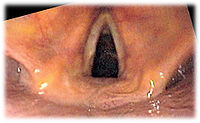
Photo from wikipedia
OBJECTIVE To compare design features and mechanical properties of 13 commercially available Veress needles (VN). STUDY DESIGN In vitro biomechanical study. SAMPLE POPULATION Veress needles from 9 manufacturers (6 reusable,… Click to show full abstract
OBJECTIVE To compare design features and mechanical properties of 13 commercially available Veress needles (VN). STUDY DESIGN In vitro biomechanical study. SAMPLE POPULATION Veress needles from 9 manufacturers (6 reusable, 6 disposable, and 1 with a reusable stylet combined with a disposable cannula) were included in the study. METHODS Veress needles are designed with a spring-loaded stylet to protect the tip of the cannula following insertion into the abdomen. Stylet forces were measured with a scale in a test jig by moving the stylet in 0.5 mm steps into the hollow cannula. Forces and spring rates were derived from force-displacement plots. Mass, mechanical dimensions, and the bevel angle and geometry were assessed. Differences between VN models were analyzed with a univariate analysis of variance. Results are reported as mean ± SD or median (range). RESULTS Physical and mechanical parameters differed between models. The exposed stylet length was 3.5 mm (2-7). Three bevel geometries (bias, lancet type, and back-cut) with angles between 20° and 40° were identified. Reusable VN weigh more (24.9 ± 2.2 g) than disposable designs (6.0 ± 2.3 g). The mean values for the spring rate and the residual stylet force were 0.23 ± 0.08 Nmm-1 and 0.94 ± 0.28 N, respectively. The mean force required to move the stylet to the cannula tip was 1.81 ± 0.29 N and 2.77 ± 0.54 N to move to the proximal end of the bevel. CONCLUSION Commercially available VN use diverse bevel geometries and have different mechanical characteristics. Studies investigating laparoscopic entry complications should explicitly report the type of VN model used.
Journal Title: Veterinary Surgery
Year Published: 2017
Link to full text (if available)
Share on Social Media: Sign Up to like & get
recommendations!